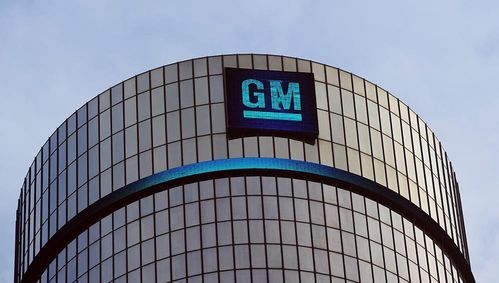
General Motors headquarters is seen in the Renaissance Center in Detroit.
(Photo: Stan Honda / Getty Images)
General Motors Co. was the only Detroit automaker to post a net loss in 2017, down $3.9 billion as it adjusts for the new tax law and takes one last hit from the money-losing European business it sold last year. But that’s not dampening optimism from the company’s leader and for investors.
“We couldn’t be more pleased about our results and the disciplined execution across all of our business units in 2017,” Chief Financial Officer Chuck Stevens said after earnings were announced Tuesday.
GM’s continuing operations — that part of the company outside of its money-losing European Opel-Vauxhall business — made $300 million last year on $145.6 billion in revenue, down 96 percent from 2016. The real bright spot was in the automaker’s pre-tax profits, which totaled $12.8 billion. That matches its record in 2016 and resulted in profit-sharing checks of up to $11,750 for GM’s roughly 50,000 hourly UAW workers.
The Detroit automaker’s earnings-per-share also reached a record $6.62. GM said last month it expected earnings-per-share of $6.50.
“The very strong results we reported this morning demonstrate the earnings power of our core business and extend our track record of meeting our commitments,” CEO Mary Barra said on a conference call with investors. “GM begins this year as a stronger, more resilient company because of the decisive actions we have taken in the past few years.”
The company implemented several changes in 2017, including strengthening its product lineup to meet rising consumer demand for crossovers and SUVs, and cutting costs with such actions as exiting Europe
GM stock closed Tuesday up 5.9 percent on a day when U.S. auto stocks outpaced the larger market: Fiat Chrysler was up 7.1 percent and Ford closed the day up 5.1 percent. By comparison, the Dow Jones Industrial Average closed Tuesday up 2.3 percent, or 567 points, a day after it plunged a record 1,175 points.
The Detroit automaker’s existing operations in the fourth quarter lost $4.9 billion on $37.7 billion in revenue. That loss is related to a non-cash $7.3 billion write-down of its tax assets in the fourth quarter of 2017. GM reported an 18.7 percent increase in pre-tax profits, earning $3.1 billion in the fourth quarter.
“We believe the bull case for GM is too positive to ignore,” Barclays analyst Brian Johnson said in a statement. “Even with the ongoing market volatility, we believe GM stock should outperform today — and we hope that the (fourth quarter) is potentially more of a catalyst to spark some momentum.”
What GM characterized as a “transformative year” comes as part of an industry-wide evolution, said Karl Brauer, an automotive analyst for Kelley Blue Book. He said automakers will have to be smart about adjusting to shrinking sales volumes — especially in the U.S. — after years of record-breaking sales and a consumer return to lucrative trucks and SUVs that fattened profit margins.
“GM has the most comprehensive approach to the market forces that exists today,” Brauer said. “I’ve never seen the company more spot-on, more nimble, more innovative or more aligned across their goals among everyone on their leadership team. That results in everything from intelligent approaches to today’s challenges, to planning for tomorrow’s challenges.”
GM heads into 2018 with a healthy line-up of new crossovers and SUVs, which the automaker expects to keep margins healthy early in 2018 while it gears up to launch the 2019 Chevrolet Silverado later in the year.
Heading into the more distant future, GM is also positioning itself for a self-driving future, upping its investment in autonomous technologies in 2018 by $600 million to $1 billion. Its overall investment in transportation-as-a-service ventures, including its ride-sharing service Maven, in 2018 will total $1.1 billion. That’s the level of investment the company thinks it needs to make this year as it moves toward its goal to launch its steering wheel-free Cruise AV in a self-driving taxi fleet next year.
That’s why investors aren’t sweating GM’s net losses in 2017, even in comparison to Ford Motor Co.’s 65 percent increase in annual profit last year — though Ford’s pre-tax profit dropped $1.9 billion from a year ago to $8.4 billion. Fiat Chrysler Automobiles’ net profit nearly doubled in 2017 to $4.35 billion (3.5 billion euros).
“All you have to do is even remotely dig into numbers and you will see the foundational strength in GM,” Brauer said.
Accounting for charges for the Opel-Vauxhall sale to PSA Groupe SA and a $7.3 billion non-cash write-down of its tax assets in the fourth quarter, GM posted a loss of $3.9 billion in 2017.
GM took a $6.2 billion hit on the year in its sale of Opel-Vauxhall, bringing down the year-end result. But the automaker is better for the European exit, as GM lost $257 million pre-tax in the region in 2016. Even that was an improvement from its $813 million pre-tax loss in the region in 2015. The automaker has said it is counting on strength in North America and China — and “improvement in South America” — to drive its performance in 2018.
Stevens said GM’s South American business was profitable in the fourth quarter — the second-straight profitable quarter — and posted a $400 million year-over-year improvement.
GM’s adjusted earnings before interest and taxes in North America totaled $11.9 billion, down from $12.4 in 2016. China joint ventures and other international operations made $1.3 billion in 2017.
Detroit News auto reporter Ian Thibodeau contributed
Read or Share this story: http://detne.ws/2FPBLhg
